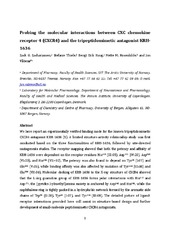Investigating the Effect of Pressure and UV Radiation on Antioxidant and UV Stabilizing Additives in Different Tire Particles
Permanent link
https://hdl.handle.net/10037/33136Date
2023-05-25Type
Master thesisMastergradsoppgave
Abstract
This thesis investigates the impact four different experimental marine conditions have on the extractability of tire additives meant to protect tires from UV radiation as well as some other common substances found in tires. The impact is evaluated between tire particle size and age to determine if the exposure affects them differently.
This thesis finds that the effect of marine conditions on extractability is more substance-dependent rather than particle size and age-dependent. In-depth evaluation of the development of extractability of five p-phenylenediamines (PPDs) was done and found that the most common among them (6PPD) had the least decrease in extractability over the course of the exposures. The same substance also had, by far, the largest percent content of them all, ranging from 64-97% of total extracted PPD content in samples. Its notorious transformation product 6PPD-Q was also detected in every single rubber sample with similar time-dependent extractability profiles as the rest of the PPDs.
Some effects of the experimental exposure on extractability were indicated. UV radiation exposure reduced the PPD extractability of the smallest particles, but no effect of UV radiation exposure could be determined on the larger particles. Experimental deep sea pressure conditions have no clear effect on the extractability of the substances. For each detected substance the latest time increment between the surface water and deep-sea samples within the same biotic influence groups was compared. It was counted that deep-sea pressure
exposed samples more frequently had a higher extractability than samples exposed to surface water pressures. No concrete tendencies could be seen over time in the hyperbaric experiments, so there was little to no development toward this conclusion.
Publisher
UiT Norges arktiske universitetUiT The Arctic University of Norway
Metadata
Show full item recordCollections
Copyright 2023 The Author(s)
The following license file are associated with this item:
Except where otherwise noted, this item's license is described as Attribution-NonCommercial-ShareAlike 4.0 International (CC BY-NC-SA 4.0)
Related items
Showing items related by title, author, creator and subject.
-
A Biofocussed Chemoprospecting Approach to Drug Discovery: Design, Synthesis and Bioactivity Screening of Diverse Biofocussed Chemical Libraries
Thakkar, Balmukund (Doctoral thesis; Doktorgradsavhandling, 2017-04-28)With pharma R & D witnessing rising cost, high attrition rates and an overall decline in productivity in recent times, newer approaches are needed for more efficient early phase drug discovery. This thesis describes a new approach, “biofocussed chemoprospecting”. The essence of the approach is to use diverse, yet “bio-like” compounds for efficient hit-finding, along with property filtering and ... -
Novel [18F]fluorinated prosthetic groups for the labelling of peptides for positron emission tyomography (PET)
Olberg, Dag Erlend (Doctoral thesis; Doktorgradsavhandling, 2009-11-20)Positron emission tomography is a non-invasive imaging modality allowing visualization and quantification of a wide variety of physiological and biochemical processes or of a specific lowdensity protein target. Some examples are blood flow, glucose consumption, fatty acid metabolism or detection and quantification of cell surface receptors in particular tissues. Within the spectrum of available ... -
Toward Tripeptidomimetic CXCR4 Antagonists: Design, Synthesis, Biological Evaluation, and Binding Mode Studies
Zachariassen, Zack George (Doctoral thesis; Doktorgradsavhandling, 2014-04-11)In order for the HIV virus to take over and destroy human immune cells, which results in AIDS, the virus first has to enter the cells. This takes place by interactions between viral proteins and specific receptors on the surface of our cells. One of these receptors is CXCR4, and it has been shown that chemical compounds that bind to and block the CXCR4 receptor, so-called CXCR4 antagonists, are able ...


 English
English norsk
norsk



